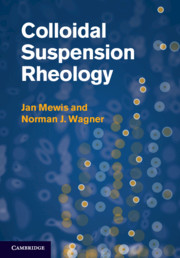Book contents
- Frontmatter
- Contents
- Preface
- General list of symbols
- Useful physical constants and values
- 1 Introduction to colloid science and rheology
- 2 Hydrodynamic effects
- 3 Brownian hard spheres
- 4 Stable systems
- 5 Non-spherical particles
- 6 Colloidal attractions and flocculated dispersions
- 7 Thixotropy
- 8 Shear thickening
- 9 Rheometry of suspensions
- 10 Suspensions in viscoelastic media
- 11 Advanced topics
- Index
- References
1 - Introduction to colloid science and rheology
Published online by Cambridge University Press: 05 December 2011
- Frontmatter
- Contents
- Preface
- General list of symbols
- Useful physical constants and values
- 1 Introduction to colloid science and rheology
- 2 Hydrodynamic effects
- 3 Brownian hard spheres
- 4 Stable systems
- 5 Non-spherical particles
- 6 Colloidal attractions and flocculated dispersions
- 7 Thixotropy
- 8 Shear thickening
- 9 Rheometry of suspensions
- 10 Suspensions in viscoelastic media
- 11 Advanced topics
- Index
- References
Summary
The subject of this book is the rheology of colloidal and nanoparticle dispersions. The reader will quickly appreciate the breadth of the subject area and, furthermore, that mastering colloidal suspension rheology requires some basic knowledge in colloid science as well as rheology. Thus, this chapter introduces some basic and simplified concepts in colloid science and rheology prior to embarking on the main theme of the book. As the term colloid is very general we necessarily need to focus on fundamental aspects of basic colloidal particles, their interactions, and their dispersion thermodynamic properties. These are, of course, the basis for understanding more complex systems. The rheology section is provided as an introduction to the basic concepts (a more advanced treatment of rheological testing of colloidal dispersions is provided in Chapter 9). Therefore, this chapter provides the minimum level of understanding that the reader will find valuable for understanding colloidal suspension rheology, as well as a means to introduce nomenclature and concepts used throughout the book. As a consequence, a reader familiar with either or both subjects may still find it valuable to skim through the material or refer back to it as needed.
Colloidal phenomena
Colloid science is a rich field with an equally rich literature. The reader is referred to a number of excellent monographs that cover the basics of colloid science in much greater detail. These will be presented without derivation. In particular, we use nomenclature and presentation of many ideas following Colloidal Dispersions [1] and Principles of Colloid and Surface Chemistry [2], which may be of help for further reading and inquiry, and for derivations of the results presented herein. Indeed, there are many additional excellent textbooks and monographs on colloid science, and references are provided where they are most relevant throughout this chapter as well as in the other chapters.
- Type
- Chapter
- Information
- Colloidal Suspension Rheology , pp. 1 - 35Publisher: Cambridge University PressPrint publication year: 2011
References
- 4
- Cited by

